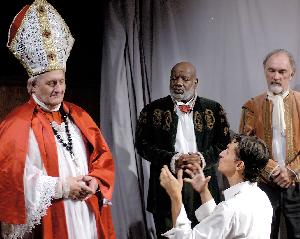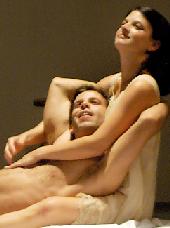SEARCH
REVIEWS
FEATURES
NEWS
Etcetera and
Short Term Listings
LISTINGS
Broadway
Off-Broadway
BOOKS and CDs
OTHER PLACES
Berkshires
London
LA/San Diego
Philadelphia
Elsewhere
QUOTES
On TKTS
LETTERS TO EDITOR
FILM
LINKS
MISCELLANEOUS
Free Updates
Masthead
Writing for us
A CurtainUp Review
'Tis Pity She's A Whore
|
Love me or kill me brother -- Annabella Love me or kill me sister -- Giovanni |

Mel Cobb (Cardinal), Helmar Augustus Cooper (Bonaventura), Mauricio Tafur Salgado (Soranzo), Craig Braun (Florio)
(Photo: David Gochfeld)
|
Even back in the 17th century playwright John Ford must have had his eye on the box-office when he titled his famous 1633 incest-coated pot-boiler of old Parma 'Tis Pity She's A Whore. As modestly presented (except for one scene that is immodest by prerequisite) by Friendly Fire at the Storm Theater, this still red hot and horrific classic is a terrific introduction to Jacobean/Carolinian dramatic literature at its most lurid.
Anyone seeing the play for the first time may well be taken by surprise at its power to arrest and arouse contemporary minds and senses. Although director Alex Lippard is severely handicapped by some of the actors' limitations and by budget constraints, his effort to give the play a sense of immediacy, if not necessarily a compelling sense of time and place, is commendable. It would seem that any skillful director would have to be invigorated to some degree by the play's eternally vexing social and ethical postures.

Rachel Mattews Black (Annabelle) & Colby Chambers (Giovanni)
(Photo: David Gochfeld) |
In short, the plot concerns the ill-fated incestuous love that bonds the middle-class Giovanni with his sister Annabella. Despite her father's wish that she marry his first choice Soranzo (Mauricio Tafur Salgado), an insincere nobleman or, if all else fails, the foolish fop Bergetto (Cameron Folmar), Annabella commits herself to Giovanni and (guess what) becomes pregnant. Bergetto is ambushed and killed by Grimaldi (Sam Chase), a Roman soldier in camouflage pants, who mistakes him for Soranzo, whom he hates. Soranzo marries her not knowing that she's pregnant with Giovanni's child, but when he does find out he wants to kill her. To avenge his lover's honor Giovanni kills Annabella and then Soranzo, only to be killed himself by Soranzo's servant Vasques (John Douglas Thompson) and his hired "banditti" (Sam Chase and Cameron Folmar) in a bloody duel. And that's just a teaser.
Nothing, not even some poor performances, seems to get in the way of this veritable feast of decadence and mind-boggling depravity. Considering the two and a half hour running time (closer to three hours with the pre-show and intermission bathroom lines), the play never bores for a minute. The fact that at times the actors' diction and performance styles lack harmony certainly gives license for some highly individualized flavors. John Douglas Thompson gives the most persuasive, conspicuously duplicitous performance as Soranzo's revenge-propelled servant Vasquez.
Other intriguing performances are given by Helmar Augustus Cooper as Donado, a citizen of Parma (repeating the role he played in the Public Theater production in 1992), Mauricio Tafu Salgado as the sadistic cuckolded nobleman Soranzo, and Mel Cobb as the mercenary unethical Cardinal and also doubling as Bergetto's servant Poggio.
Catherine Curtin's abrasive shrillness as the sluttish Hippolita was as unintelligible as she was out-of-control. This was contrasted by the non-performance of Craig Baldwin, as her mock physician husband Richardetto.
Hammy Jan Leslie Harding unmercifully chewed up the scenery (although there was precious little of it to chew) as the untrustworthy Putana. No worse for the carnage around her, Betsy Winchester, as Richardetto's niece Philotis, survived in one piece.
Mired as it is in murder and mayhem, this extraordinary play barrels along by the sheer force of its inherently involving melodramatics. Scholars of the period would undoubtedly credit Ford for his amusingly flagrant disregard for high-toned classicism. And certainly enough has been speculated about Ford's artful balancing of tragedy and social satire, to give plenty of freedom to directors. In this case, director Lippard should have felt free to murder some of the cast.
The play's blatant almost parodic similarities to Shakespeare's Romeo and Juliet also leaves room for a director to have some dopey fun with the revenge-doesn't-pay theme. When it comes to dopey, Folnar's flamboyantly fey posturing, with his garbled speech getting lost in his own giggles and his farcical fashion statement -- a bright red suit, yellow stockings and turquoise shoes -- reveal more than anything this pretentious fool has to say. With the budget apparently shot on Bergetto's getup, the company is otherwise dressed in apparel from all eras.
Set designer Michael V. Moore's audacious use of bed sheets strung across a pair of clothes lines and one raised platform doesn't begin to suggest anything close to baroque. In this regard, Lippard embraces the plot's rampant hugger-muggery with go-for-baroque abandon. A birthday celebration that ends in a blood bath and the lovers' tryst rise graphically out of the text and are effectively staged.
My first encounter with this worthy relic was at the Public Theater 13 years ago. Val Kilmer and Jeanne Tripplehorn co-starred under the direction of JoAnne Akalaitis. As this is only the second time I've seen the play, my reaction remains one of awe and amazement at Ford's flagrantly violent, yet psychologically profound point of view. 'Tis pity that this production is only fleetingly in touch with it.
|
'Tis Pity She's a Whore By John Ford Directed by Alex Lippard Cast: Craig Baldwin, Rachel Matthews Black, Craig Braun, Colby Chambers, Sam Chase, Mel Cobb, Helmar Augustus Cooper, Catherine Curtin, Cameron Folmar, Jan Leslie Harding, Mauricio Tafu Salgado, John Douglas Thompson, Betsy Winchester Set Design: Michael V. Moore Costume Design: Martin T. Lopez Lighting Design: Scott Bolman Sound Design and Original Music: Allison Leyton-Brown Fight Director: Rick Sordelet Running Time: 2/1/2 hours, plus one intermission Performances run September 29 - October 21 Friendly Fire at The Storm Theatre, 145 West 46th Street (Broadway/ 6th Avenue, third floor) 212 - 352 - 3101 For additional information, visit www.friendlyfiretheatre.org From 9/29/05 to 10/21/05; opening 10/01/05 Thursday, Fridays and Saturdays at 8pm; plus Sunday, October 2 at 7pm; Sundays, October 9 & 16 at 3pm; Saturday October 15 at 2pm; and Wednesday, October 19 at 8pm. Tickets: $15 Reviewed by Simon Saltzman based on October 1st performance |

Easy-on-the budget super gift for yourself and your musical loving friends. Tons of gorgeous pictures.

>6, 500 Comparative Phrases including 800 Shakespearean Metaphors by our editor.
Click image to buy.
Go here for details and larger image.








